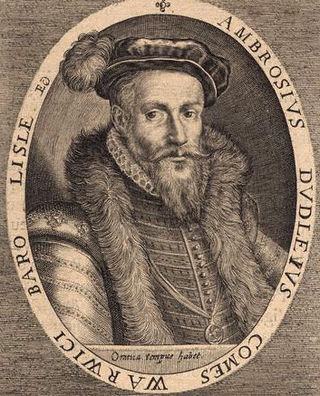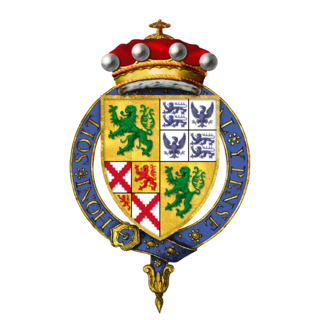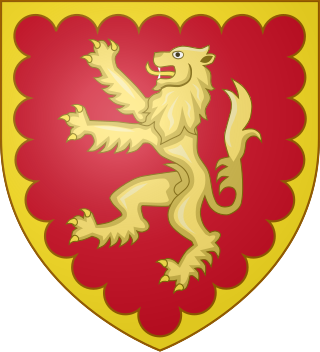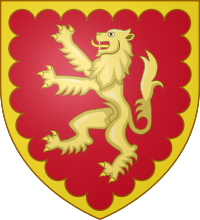
Katherine Seymour, Countess of Hertford was a younger sister of Lady Jane Grey.

Earl of Warwick is one of the most prestigious titles in the peerages of the United Kingdom. The title has been created four times in English history, and the name refers to Warwick Castle and the town of Warwick.

Duke of Northumberland is a noble title that has been created three times in English and British history, twice in the Peerage of England and once in the Peerage of Great Britain. The current holder of this title is Ralph Percy, 12th Duke of Northumberland.

Baron Hastings is a title that has been created three times. The first creation was in the Peerage of England in 1290, and is extant. The second creation was in the Peerage of England in 1299, and became extinct on the death of the first holder in c. 1314. The third creation was in the Peerage of England in 1461, and has been in abeyance since 1960.

Baron FitzWalter is an ancient title in the Peerage of England. It was created on 24 June 1295 for Robert FitzWalter. The title was created by writ, which means that it can descend through both male and female lines.

Viscount De L'Isle, of Penshurst in the County of Kent, is a title in the Peerage of the United Kingdom. It was created in 1956 for William Sidney, 6th Baron de L'Isle and Dudley, VC, KG, GCMG, GCVO (1909–1991).
Baron Lisle was a title which was created five times in the Peerage of England during the Middle Ages and Tudor period, and once in the Peerage of Ireland in the 18th century.

Edward Stafford, 2nd Earl of WiltshireKB was an English nobleman.
John Dudley, 2nd Earl of Warwick, KB was an English nobleman and the heir of John Dudley, 1st Duke of Northumberland, leading minister and regent under King Edward VI from 1550–1553. As his father's career progressed, John Dudley respectively assumed his father's former titles, Viscount Lisle and Earl of Warwick. Interested in the arts and sciences, he was the dedicatee of several books by eminent scholars, both during his lifetime and posthumously. His marriage to the former Protector Somerset's eldest daughter, in the presence of the King and a magnificent setting, was a gesture of reconciliation between the young couple's fathers. However, their struggle for power flared up again and ended with the Duke of Somerset's execution. In July 1553, after King Edward's death, Dudley was one of the signatories of the letters patent that attempted to set Lady Jane Grey on the throne of England, and took arms against Mary Tudor, alongside his father. The short campaign did not see any military engagements and ended as the Duke of Northumberland and his son were taken prisoners at Cambridge. John Dudley the younger was condemned to death yet reprieved. He died shortly after his release from the Tower of London.

Ambrose Dudley, 3rd Earl of Warwick, KG was an English nobleman and general, and an elder brother of Queen Elizabeth I's favourite, Robert Dudley, Earl of Leicester. Their father was John Dudley, Duke of Northumberland, who led the English government from 1550–1553 under King Edward VI and unsuccessfully tried to establish Lady Jane Grey on the English throne after the King's death in July 1553. For his participation in this venture Ambrose Dudley was imprisoned in the Tower of London and condemned to death. Reprieved, his rehabilitation came after he fought for King Philip in the Battle of St. Quentin.

Edward Sutton, 2nd Baron Dudley, was an English nobleman elected as Knight of the Garter (KG) in the beginning of King Henry VIII's reign. He was chamberlain to Princess Mary from 1525 to 1528.
Earl of Sussex is a title that has been created several times in the Peerages of England, Great Britain, and the United Kingdom. The early Earls of Arundel were often also called Earls of Sussex.

Edmund Dudley was an English administrator and a financial agent of King Henry VII. He served as a leading member of the Council Learned in the Law, Speaker of the House of Commons and President of the King's Council. After the accession of Henry VIII, he was imprisoned in the Tower of London and executed the next year on a treason charge. While waiting for his execution he wrote The Tree of Commonwealth. Edmund Dudley was also the grandfather of Robert Dudley, 1st Earl of Leicester, a favourite of Henry VIII's daughter, Elizabeth I.

The titles Baron Montacute or Baron Montagu were created several times in the Peerage of England for members of the House of Montagu. The family name was Latinised to de Monte Acuto, meaning "from the sharp mountain"; the French form is an ancient spelling of mont aigu, with identical meaning.

There have been two baronetcies created for persons with the surname Yelverton, both in the Baronetage of England.
Jane Dudley, Duchess of Northumberland was an English courtier. She was the wife of John Dudley, 1st Duke of Northumberland, and mother of Guildford Dudley and Robert Dudley, 1st Earl of Leicester. Having grown up with her future husband, who was her father's ward, she married at about age 16. They had 13 children.
Elizabeth Grey, 6th Baroness Lisle was an English noblewoman during the reigns of Henry VII and VIII.

Edward Grey, 1st Viscount Lisle was an English nobleman who was created Viscount Lisle in 1483, in recognition of his wife's descent.
Henry Dudley was an English soldier and an elder brother of Queen Elizabeth I's favourite, Robert Dudley, Earl of Leicester. Their father was John Dudley, Duke of Northumberland, who led the English government from 1550 to 1553 under Edward VI and unsuccessfully tried to establish Lady Jane Grey on the English throne after the King's death in July 1553. For his participation in this venture Henry Dudley was imprisoned in the Tower of London and condemned to death.

John Grey, 2nd Viscount Lisle was a British peer of the Tudor period. Upon his death the title Viscount Lisle became extinct, but the Barony of Lisle passed to his unborn daughter Elizabeth, his only child.













